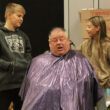Sean C. Morgan
Attorneys for Albany and Eastern Railroad and residents of Country Lane argued Thursday morning, March 12, before the Oregon Supreme Court whether the railroad crossing at Country Lane was what is considered a “common road.”
After purchasing land under the rail line in 2012, the railroad moved to charge property owners along the line, on the east side of Highway 20 northwest of Sweet Home, permit and maintenance fees. This came after decades during the previous railroad owners did not charge residents.
Country Lane residents refused to pay and Albany and Eastern sued them in court.
Country Lane won at trial in Linn County District Court, but Albany and Eastern appealed the decision. The Oregon Court of Appeals ruled in favor of the railroad last year, citing a 2016 Oregon Supreme Court decision in Wels v. Hippe.
The Country Lane residents appealed to the Oregon Supreme Court, which heard arguments Thursday.
The bottom line in the case between Country Lane and Albany and Eastern Railroad comes down to Country Lane neighbors’ claim that they have been trespassing on Albany and Easter Railroad’s crossing to reach Highway 20 since at least 1953. The reason that is critical is that it gives those residents the right to continue doing so without paying Albany and Eastern a permit fee and an annual maintenance fee. That’s after almost 70 years of use by that neighborhood and use going even further back into the fog of history, 1910, before the railroad even existed.
Albany and Eastern argues that the railroad has been giving the neighbors, along with the general public, that right. After its 2012 purchase of the rail line and the property it sits on, the railroad has decided to stop treating Country Lane as a public crossing, treat it like a private crossing and charge residents annual payments for maintenance and insurance.
The issue in the case before the Oregon Supreme Court centers on whether Country Lane residents’ use of the crossing is adverse – interferes – with the use of the property by the railroad itself or whether that is even the standard the Court must use to decide this case. If the court rules that the use is adverse, that the railroad never really gave permission for the residents to use the crossing, then the residents will win. If the court rules that the use was not adverse, the railroad will prevail.
A decision is expected by the end of the year.
Defendants’ Argument
Country Lane attorney Dan Armstrong of Corvallis contended that the neighborhood’s use of the crossing has been “presumptively adverse” and “actually adverse” to the railroad’s interests, that its use of the crossing has always interfered with the railroad’s use of its property as a railroad. As a result, the residents claim a “prescriptive easement” over the crossing and a right to use the crossing.
Albany and Eastern attorney Martin E. Hansen of Bend argued that Country Lane’s use of the common road in Wels was a friendly arrangement between neighbors rather than adverse use and that Country Lane residents never interfered with use of the railroad, and that those facts undermine claims of adverse use.
The Linn County trial court found no evidence that the railroad granted permission, Armstrong said, and the Court of Appeals found that the defendants, Country Lane, did not have permission to use the crossing. Railroad officials testified that the railroad never gave permission.
“Its testimony proved that no sane railroad would ever give permission to cross,” Armstrong said. “It testified it ‘would prefer not to have any crossings, private or public’” and that “‘private crossings like Country Lane interfere with railroads’ and are a ‘constant cost.’
“It built a road that was adverse to itself. The railroad didn’t build this crossing for itself.”
The railroad built the crossing to protect its rails from vehicle traffic, Armstrong said, to prevent traffic from twisting the rails.
The railroad claimed that its crossbuck signs were an invitation to the public to cross the railroad at that location, he said, arguing that a crossbuck is a warning, not an invitation or welcome sign.
The argument doesn’t change simply because the railroad’s predecessors and the state and federal governments mistakenly believed the crossing was public, Armstrong said, noting that the road goes nowhere except to Country Lane residences, who are blocked by the South Santiam River to the east.
The crossing itself pre-existed the railroad, Armstrong said, and the 1928 deed to the railroad right-of-way required the railroad to maintain a crossing as a private driveway for property north of Country Lane, called the “Murray property,” which was divided in 1910 from property that included Country Lane prior to the construction of the rails line.
Part of Country Lane itself, Armstrong said, is shared between the Murray property and the eight-lot Country Lane.
“The crossing isn’t a road,” Armstrong said. “It isn’t used by the railroad. It isn’t used in common by the parties. There is no evidence that the railroad ever used the crossing. There is no evidence that the Murray property ever used the crossing. Only defendants used it.”
The trial court found that Country Lane was not a common road, and it was not built to benefit the railroad, Armstrong said.
“The residents are not incidental users of a roadway that was constructed by the railroad for the benefit of the railroad. There is no presumption of permission.”
Railroad Argument
“The Court of Appeals consistently applied this (Supreme) court’s ruling in Wels,” Hansen said, adding that looking at this case, there is no adversity present.
The owner of the southern property, Country Lane, never required a crossing when selling right-of-way to the railroad, he said, and the reason for failing to reserve an easement is “lost to time.”
Albany and Eastern’s predecessor began treating Country Lane like a public crossing in 1953, Hansen said. Crossbuck signs notified the general public it was welcome to use the crossing.
The primary issue is adversity, he said, whether the defendants’ use of the crossing entitled a presumption of adversity and a prescriptive easement.
Hansen said their use of the crossing was non-exclusive. Anyone could use it, which shows that the defendants’ use of the crossing was permissive. Even if it were not permissive, the residents never put the railroad on notice that the use was allegedly adverse; their use never interfered with the use of the railroad.
Economic interference is not supported by Oregon law, so the defendants’ claims that the cost of maintaining the crossing in order to protect the rails does not support their claim, Hanson said.
“Specifically, the record is devoid of evidence that defendants’ use of the Country Lane Crossing ever caused a train to stop, slow down, divert to another track or collide with anything.” Rather, evidence shows they crossed the tracks while the railroad allowed unfettered access to the general public.
The crossing is not sufficiently different from common use of a road to warrant a different standard, Hansen said. Rather than a stretch of road used by the parties, the crossing serves as an intersection that is used by the railroad – “it’s a common road, albeit perpendicular.”
“To establish a prescriptive easement, the claimant must show an open and notorious use of the servient land adverse to the rights of the owner for a continuous and uninterrupted period of 10 years,” he said. An adverse use may be proven by evidence that the claimant’s use of property interfered with the owner’s, and the defendants did not prove their use was actually adverse.
Under the Wels decision, a claim of adverse use depends on the extent that the claimant’s use interferes with the owner’s use of a common road, Hansen said.
They had permission to cross, along with the public, Hansen said, and a permissive use can never be adverse. The crossbuck signs are notice to the public that the crossing is open to the public in general. Hansen argued that the crossing has been used by delivery drivers, visitors and others.
Even if the railroad’s predecessor mistakenly believed that it was a public crossing, it doesn’t change the fact that the railroad gave board permission to cross there to the general public, so nothing about Country Lane’s use of the crossing put the railroad on notice it needed to protect its interest in the property against the defendants, notice being a requirement to claim adversity.
“The key in this case is interference and the lack thereof,” Hansen said. “They don’t have any actual interference with their (railroad’s) use of the right-of-way. Maintenance cost is irrelevant to adversity.”
Supreme Court Justices
The Murray property included a flagpole to reach the crossing. That flagpole is shared with Country Lane properties, and Country Lane itself is wider than the flagpole and owned by the residents. The Murray property is reached through a gate where the flagpole turns north off Country Lane to the Murray farm property.
Supreme Court justices quizzed the attorneys about that configuration and the facts of the case.
“Was there any reason to treat it as a public road?” asked Justice Meagan Flynn.
“No, it’s a dead end,” Armstrong said.
Chief Justice Martha Lee Walters asked if the railroad had to maintain the crossing for the Murray property. Armstrong told her that it only had to maintain it for those crossing it to use the Murray property, which it did not have; but it has been in use by Country Lane residents since 1953.
Murray property users can access it for farming, even though that use may be infrequent, Hansen said.
Flynn asked if the railroad could make Country Lane public rather than posting it as a private crossing. Armstrong told her Country Lane is private property.
Justice Lynn Nakamoto asked Hansen why there is no presumption of adversity in this case. Hansen said the nature of the land is common use.
Walters asked how the crossing is being used by the railroad. Hansen told her the railroad crosses it, like an intersection of two roads.
Flynn asked, if Murray gave permission to Country Lane to use Murray’s flagpole and crossing, whether the railroad could object.
If it added to the burden at the crossing, Hansen said.
Nakamoto noted that there was only a reason for Murray to reserve an easement because the flagpole was part of that property and used to access the crossing. It’s reasonable that Edna Strickler Murray’s brother, Robert H. Sharinghousen, who owned the southern parcel, Country Lane, could have had a deal with her to use her property for access to Highway 20.
Walters wondered if Sharinghousen had created 70 properties – rather than eight – that used the same crossing under Murray’s easement, if that would put the railroad on notice.
The use of the crossing was not exclusive, Hansen said, so it would not, adding that he has never seen expansion of use create a prescriptive easement.
The claimants must show that their use interfered with the property owner’s, Hansen said. “That’s not present here.”
Normally, Walters said, if someone “drives a car across your property” for 10 years, that’s adversity.
If someone drove across a lawn, yes, Hansen said, but the crossing is a common road.
“It’s not a common road case,” Armstrong said.
Flynn asked why not.
The railroad doesn’t use it, Armstrong said.
“We have the presumption of adversity,” Walters said, but if it’s a common road case, the court needs proof of interference.
If Country Lane were using the Murray property, the flagpole to reach the crossing, Flynn asked Armstrong how the railroad could stop it.
The railroad could send letters and tell the Murray property owner to stop allowing it, Armstrong said. There is no deal that Murray could make that would give Country Lane a right to use the flagpole to access Murray’s crossing. If there were, Murray could allow properties clear to the Mississippi River to use it to reach Highway 20.
To deal with it, the railroad could do what Albany and Eastern did within two weeks of buying it, Armstrong said: survey it and send letters.
The Supreme Court, which was originally supposed to meet at the University of Oregon, wrapped up the session by answering questions about its work from law students in attendance.
Present at the arguments were justices Christopher L. Garrett, Rebecca A. Duncan, Nakamoto, Walters, Thomas A. Balmer, Flynn and Adrienne C. Nelson.
Residents of Country Lane named in the lawsuit are Michael and Cindy Martell, John and Elaine Harcrow, Jeffrey and Beverly Kaiser, Joanne Fagan, Ray and Michelle McMullen, Jeremy and Karen Orr, Richard and Jill Hutchings and Laurae Mithoug.




